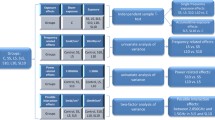Summary
The effects of whole body microwave exposure on the central nervous system (CNS) of the rat were investigated. Rats weighing from 250 to 320 g were exposed for 1 h to whole body microwave with a frequency of 2450 MHz at power densities of 5 and 10 mW·cm−2 at an ambient temperature of 21–23°C. The rectal temperatures of the rats were measured just before and after microwave exposure and mono-amines and their metabolites in various discrete brain regions were determined after microwave exposure. Microwave exposure at power densities of 5 and 10 mW·cm−2 increased the mean rectal temperature by 2.3°C and 3.4°C, respectively. The noradrenaline content in the hypothalamus was significantly reduced after microwave exposure at a power density of 10 mW·cm−2. There were no differences in the dopamine (DA) content of any region of the brain between microwave exposed rats and control rats. The dihydroxyphenyl acetic acid (DOPAC) content, the main metabolite of DA, was significantly increased in the pons plus medulla oblongata only at a power density of 10 mW·cm−2. The DA turnover rates, the DOPAC:DA ratio, in the striatum and cerebral cortex were significantly increased only at a power density of 10 mW·cm−2 The serotonin (5-hydroxytryptamine, 5-HT) content in all regions of the brain of microwave exposed rats was not different from that of the control rats. The 5-hydroxyindoleacetic acid (5-HIAA) content in the cerebral cortex of microwave exposed rats was significantly increased at power densities of 5 and 10 mW·cm−2. The 5-HT turnover rates and the 5-HIAA:5-HT ratio were significantly increased in the cerebral cortex at a power density of 5 mW·cm−2. Significant increases in the 5-HT turnover rate were observed in the pons plus medulla oblongata and hypopthalamus at a power density of 10 mW·cm−2. These results indicated that whole body microwave exposure with a frequency of 2450 MHz at power densities of 5 and 10 mW·cm−2 affected the function of mono-aminergic neurons in the rat brain. It would seem that the effects of whole body microwave exposure on the CNS can be attributed to the hyperthermia characteristic of microwave exposure, although the direct effects of microwave irradiation on the CNS cannot be completely discarded.
Similar content being viewed by others
References
Baker MA (1982) Brain cooling in endotherms and exercise. Annu Rev Physiol 44: 85–96
Cabanac M (1975) Temperature regulation. Annu Rev Physiol 37: 415–439
Colboc O, Costentin J (1980) Evidence for thermoregulatory dopaminergic receptors located in the preoptics medialis nucleus of the rat hypothalamus. J Pharm Pharmacol 32: 624–629
Feldberg W, Myers A (1963) A new concept of temperature regulation by amines in the hypothalamus (abstract). Nature 200: 1325
Glowinski J, Iversen LL (1966) Regional studies of catecholamines in the rats brain-1. J Neurochem 13: 655–669
Hardy JD, Hellon RF, Sutherland K (1964) Temperature-sensitive neurons in the dog's hypothalamus. J Physiol (Lond) 175: 242–253
Hensel H (1981) Thermoreceptor and temperature regulation. Academic Press, London
Lowry OH, Losenbrough NJ, Farr AL, Randall RJ (1951) Protein measurement with the folin phenol reagent. J Biochem 193: 265–275
Merrit JH, Chamness AF, Hartzell RH, Allen SJ (1977) Orientation effects on microwave-induced hyperthermia and neurochemical correlates. J Microw Power 12: 167–172
Myers RD (1980) Hypothalamic control of thermoregulation: neurochemical mechanisms. In: Morgane PJ, Panksepp J (eds) Handbook of the hypothalamus, vol. 3, part A. Dekker, New York, pp 83–210
Nakayama T, Hammel HT, Hardy JD, Eisenman JS (1963) Thermal stimulation of electrical activity of single units of the preoptic region. Am J Physiol 204: 1122–1126
Simmonds MA (1970) Effects of environmental temperature on the turnover of 5-hydroxytryptamine in various areas of rat brain. J Physiol (Lond) 211: 93–108
Simmonds MA, Iversen LL (1969) Thermoregulation: effects of environmental temperature on turnover of hypothalamic norepinephrine. Science 163: 473–474
Yamagichi K, Arai H, Watanabe N, Moroji T (1982) Simultaneous determination of biogenic amines and their metabolites in brain tissue by HPLC with electrochemical detection. Jpn J Psychopharmacol 2: 9
Yamawaki S, Lai H, Horita A (1983) Dopaminergic and serotonergic mechanisms of thermoregulation: mediation of thermal effects of apomorphine and dopamine. J Pharmacol Exp Ther 227: 383–388
Watanabe T, Morimoto A, Murakami N (1986) Effects of amine on temperature-responsive neuron in slice preparation of rat brain stem. Am J Physiol 250: R553–559
Author information
Authors and Affiliations
Rights and permissions
About this article
Cite this article
Inaba, R., Shishido, Ki., Okada, A. et al. Effects of whole body microwave exposure on the rat brain contents of biogenic amines. Europ. J. Appl. Physiol. 65, 124–128 (1992). https://doi.org/10.1007/BF00705068
Accepted:
Issue Date:
DOI: https://doi.org/10.1007/BF00705068




